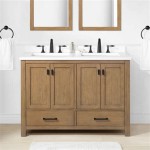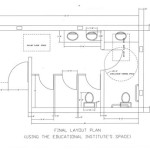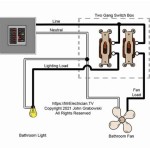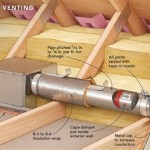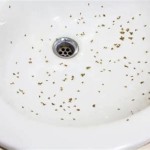DIY Floating Bathroom Vanity Ideas: A Comprehensive Guide
The floating bathroom vanity, also known as a wall-mounted vanity, has gained significant popularity in modern bathroom design. Its sleek, minimalist aesthetic not only enhances the visual appeal of the space but also provides practical benefits such as increased floor space and easier cleaning. For homeowners seeking a personalized touch and cost-effective solutions, DIY floating bathroom vanities offer an excellent opportunity to create a unique and functional centerpiece. This article explores various DIY floating bathroom vanity ideas, focusing on design considerations, material selection, construction techniques, and installation procedures.
Understanding the Benefits and Considerations
Before embarking on a DIY floating bathroom vanity project, it is crucial to understand the advantages and potential challenges associated with this design choice. A primary benefit is the illusion of a larger bathroom. By exposing the floor beneath the vanity, the perceived space is increased, making smaller bathrooms feel more open and airy. Furthermore, cleaning becomes significantly easier as there are no legs or a base to navigate around. This accessibility is particularly advantageous for individuals with mobility issues.
However, floating vanities require careful planning and execution. Because the entire weight of the vanity and its contents is supported by the wall, proper wall reinforcement is essential. This typically involves attaching the vanity to wall studs or using specialized mounting hardware designed for heavier loads. The structural integrity of the wall itself is also a critical factor. Drywall alone is insufficient; a solid backing, such as plywood or a reinforced frame, is necessary to ensure stability. Moreover, plumbing considerations are paramount. The drain and water supply lines must be properly concealed within the wall, requiring careful planning and precise execution to avoid future leaks or accessibility issues.
Budget is also a significant consideration. While DIY projects often offer cost savings, the expense of materials, hardware, and potential specialized tools can add up. Additionally, the time investment required for design, construction, and installation should not be underestimated. A thorough assessment of personal skills and available time is crucial before committing to a DIY floating vanity project.
Exploring Design Options and Material Selection
The design possibilities for DIY floating bathroom vanities are virtually limitless, allowing homeowners to tailor the vanity to their specific aesthetic preferences and functional needs. One popular option is a simple, rectangular vanity with a clean, minimalist design. This style is particularly well-suited for modern and contemporary bathrooms. Another approach is to incorporate open shelving into the vanity, providing both storage and display space. This design can be particularly effective in smaller bathrooms where maximizing storage is a priority.
For those seeking a more rustic or industrial look, salvaged wood or reclaimed materials can be used to construct the vanity. These materials add character and texture to the bathroom, creating a unique and visually appealing focal point. Alternatively, concrete or composite materials can be used to create a sleek and modern vanity with a durable and water-resistant surface. The choice of material will depend on the desired aesthetic, budget, and skill level of the DIYer.
When selecting materials, it is essential to consider their durability and resistance to moisture. Bathrooms are inherently humid environments, and materials that are susceptible to water damage should be avoided. Solid wood, when properly sealed and finished, can be a viable option. However, moisture-resistant alternatives such as marine-grade plywood or medium-density fiberboard (MDF) are often preferred. These materials are less prone to warping and swelling in humid conditions. The countertop material should also be water-resistant and easy to clean. Popular options include quartz, granite, and solid-surface materials.
Hardware selection is another crucial aspect of the design process. The type of mounting hardware used to attach the vanity to the wall is critical for ensuring stability and safety. Heavy-duty floating vanity brackets or steel support frames are recommended for larger or heavier vanities. Soft-close hinges and drawer slides can add a touch of luxury and convenience to the vanity. The choice of knobs or pulls should complement the overall design aesthetic and provide a comfortable grip.
Step-by-Step Construction and Installation Guide
Constructing a DIY floating bathroom vanity involves a series of steps, from planning and measuring to cutting, assembling, and finishing. The following guide provides a general overview of the process:
- Planning and Measuring: Begin by determining the desired dimensions of the vanity. Consider the size of the bathroom, the location of plumbing fixtures, and the amount of storage space required. Create a detailed sketch or blueprint of the vanity, including all measurements and material specifications.
- Material Preparation: Purchase the necessary materials and hardware based on the design specifications. Cut the materials to the required dimensions using a saw or router. Ensure that all cuts are accurate and clean.
- Assembly: Assemble the vanity carcass using wood glue and screws or nails. Reinforce the corners and joints for added stability. If incorporating drawers or shelves, construct these separately and install them into the carcass.
- Finishing: Sand the vanity to create a smooth surface. Apply a primer and paint or stain to the vanity, ensuring that all surfaces are properly sealed and protected from moisture. Consider applying multiple coats for added durability.
- Countertop Installation: Install the countertop onto the vanity carcass using adhesive or screws. Ensure that the countertop is level and securely attached. Cut out the necessary holes for the sink and faucet.
- Plumbing Installation: Connect the sink and faucet to the water supply and drain lines. Ensure that all connections are tight and leak-free. Hire a qualified plumber if you are not comfortable with plumbing work.
- Wall Mounting: Locate the wall studs or install a reinforced backing frame. Attach the mounting hardware to the wall and the vanity. Carefully lift the vanity into place and secure it to the mounting hardware. Ensure that the vanity is level and stable.
- Finishing Touches: Install the knobs or pulls on the drawers and doors. Caulk around the edges of the countertop and the vanity to prevent water damage. Clean the vanity and surrounding area.
This step-by-step guide provides a basic framework for constructing and installing a DIY floating bathroom vanity. The specific steps and techniques will vary depending on the design and materials used. It is essential to consult with experienced DIYers or professionals if you encounter any challenges or have questions about the process.
Addressing Common Challenges and Troubleshooting
DIY projects often present unexpected challenges, and constructing a floating bathroom vanity is no exception. One common issue is ensuring adequate wall support. If the wall studs are not located in the ideal position, a reinforced backing frame may be necessary. This frame should be constructed from sturdy lumber and securely attached to the wall studs using screws or lag bolts. The vanity can then be attached to the backing frame, providing a solid and stable mounting surface.
Another challenge is concealing the plumbing lines. The drain and water supply lines must be routed through the wall and connected to the sink and faucet. This requires careful planning and precise execution. Consider using flexible supply lines to make the connections easier. It is also essential to ensure that the drain line has the proper slope to prevent clogs. If you are unsure about how to properly route the plumbing lines, consult with a qualified plumber.
Leveling the vanity is also crucial. If the vanity is not perfectly level, the countertop may be uneven, and the drawers or doors may not close properly. Use a level to ensure that the vanity is plumb and level before securing it to the wall. Shims can be used to make minor adjustments.
Finally, preventing water damage is essential. Bathrooms are inherently humid environments, and materials that are susceptible to water damage should be avoided. Solid wood should be properly sealed and finished, and moisture-resistant alternatives such as marine-grade plywood or MDF should be used whenever possible. Caulk around the edges of the countertop and the vanity to prevent water from seeping behind the vanity. Regularly inspect the vanity for signs of water damage and address any issues promptly.
By carefully planning and executing each step of the process, homeowners can create a beautiful and functional DIY floating bathroom vanity that enhances the aesthetic appeal and functionality of their bathroom. While challenges may arise, with careful attention to detail and a willingness to learn, a successful outcome is achievable.

How To Diy Your Own Floating Vanity Kristina Lynne

Diy Floating Bathroom Vanity Remodelando La Casa

How To Build A Diy Floating Vanity With Wood For Less Than 30

How To Build A Diy Modern Floating Vanity Or Tv Console

Diy Floating Vanity Ideas For Bathroom

Diy Floating Wood Vanity Step By Infarrantly Creative

Diy Floating Wood Vanity Step By Infarrantly Creative

How To Build A Diy Floating Vanity With Wood For Less Than 30

Diy Bathroom Floating Vanity With Drawers Hydrangea Treehouse

Diy Floating Bathroom Vanity Remodelando La Casa
Related Posts
